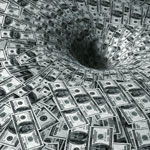Gold & Precious Metals
I think first of all investors must realize that the impact of a slowdown in the Chinese economy, which in my view is much larger than what the government has been reporting, the government says GDP has been growing at 7.8%, in my view it’s much lower because we have very reliable statistics.
The two countries where the exports were predominantly China-geared – Taiwan and South Korea and where the statistics are more reliable than what the Chinese announced in GDP growth, these countries have negative export growth on a year-on-year bases in the last month in June. If these countries have declining exports, it tells you something about the Chinese economy.
We have other reliable statistics like gaming revenues in Macau and so forth. The overall revenues are still up but the junkit turnover is down. These are middle men who bring the gamblers to Macau. Their growth rate has slowed down, luxury consumption has slowed down and electricity consumption is basically flat. Steel and cement production is up maximum 2-4% year-on year and so we have some reliable statistics.
Macdonalds just reported that their sales in Asia year-on-year is down more than 1%. Believe me if in a growth region, where markets are not yet saturated and where shops like MacDonalds are like prestige things for families to go and where their sales are down believe me – something is not quite right. I can see it with my own eyes. I don’t think that in Asia at the present time there is any economic growth.
When the Chinese economy was strong 2000-2008, it drove up commodity prices and that boosted growth rates in emerging economies such as Brazil, Argentina, and the oil-producing countries in the Middle East, and central Asia, Russia and of course also Africa and Australasia.
When the Chinese economy slumps, then obviously the demand for commodities goes down and these countries have less money and so they buy less and so it has a very strong multiplier effect on the global economy.
I think that the slowdown in the Chinese economy – and believe me, the Chinese economy did not grow in the second quarter by 7.8% – in my view, maximum 3%.
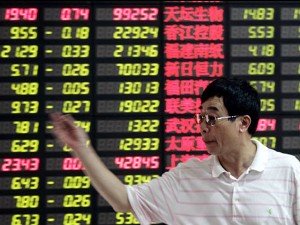
07/18/12 Madrid, Spain – You can’t help but feel sorry for the bankers. Yesterday, one of them was so upset and humiliated he tended his resignation — at a Senate hearing.
One after another the bankers mount the scaffold. Goldman, JP Morgan, Barclays…and now HSBC. One loses money. Another rigs LIBOR rates.
One fiddles an entire nation’s books. And another helps terrorists, drug dealers and money launderers with their banking needs.
That last charge is the one leveled against HSBC yesterday, causing the bank’s chief of compliance to quit, on the spot. Here’s the accusation:
…using a global network of branches and a US affiliate to create a gateway into the American financial system that led to more than $30bn in suspect transactions linked to drugs, terrorism and business for sanctioned companies in Iran, North Korea and Burma.
This spectacle may be entertaining, but in our view, it is fundamentally meaningless.
Here’s what really happened:
The feds created a funny money, back in the early ’70s. Unlike the gold-backed dollar, this one was almost infinitely flexible. It would allow the financial system to create trillions-worth of new cash and credit, vastly expanding the amount of debt in the system…and greatly increasing the profits of the banking sector.
The financial industry — the dispenser of the need money — set to work, creating fancy new ways to move the new money around. Each time it closed a deal, it made a profit. Naturally, it was encouraged to find all manner of clever ways to make deals.
Then, when the credit bubble blew up in ’08-’09 many of these tricks of the trade didn’t look so clever. They looked sinister. Stupid. Or crooked.
“When the tide goes out,” says Warren Buffett, “you see who’s been swimming naked.”
It is not a pretty sight.
Billions of dollars were lent to people who shouldn’t have been allowed to borrow lunch money. And now, there are losses — trillions worth.
The real question — the only question of great significance since the blow-up — is: who will take the losses? Or, to put it another way: How will the system be cleaned up? Who will decide who wins and who loses?
Mr. Market or Mr. Politician?
Let investors and speculators take the losses…or put them on savers and taxpayers?
Who will lose? The rich? Or the rest?
We’ve given you our answer many times: let Mr. Market sort it out. He’s completely impartial. He’s honest. He’s fast. And he works cheap.
In a flash, back in September-December of ’08, he probably would have wiped up the floor with the bankers. In a real crash, few of the big banks would have remained standing. Investors and lenders who had put their money in them…and who had invested in the things their phony credits supported…would have lost trillions. The rich wouldn’t be so rich anymore. And we’d now be in some phase of real recovery with many new financial institutions.
But we’re not in a position to impose our will on the world. And the politicians are. So, they’ve decided to do it another way. Instead of allowing Mr. Market to do his work they make their own choices…generally trying to direct the losses towards groups of people who don’t make campaign contributions…and don’t know what is going on. That is, towards the masses…and the unborn…
The idea has been to kick the can as far down the road as possible…borrowing and printing trillions more dollars to prop up the financial system…while also parading a few bankers through the streets with nooses around their necks. The press insults them. The mob spits upon them. The public spectacle continues…
…and nothing really changes.
Regards,
Bill Bonner,
for The Daily Reckoning
Read more: A Crisis Veiled in Public Spectacle http://dailyreckoning.com/a-crisis-veiled-in-public-spectacle/#ixzz214kPGzyg
Gold equities and related exchange traded funds listed on the TMX finally came alive on Friday after gold bullion prices rose sharply on news that China’s second quarter GDP recorded a healthy 7.6 per cent annual growth rate. Gold advanced to US$1,587.10 per ounce and briefly broke above its 20 and 50 day moving averages.
Seasonal influences for gold and gold stocks are starting slightly earlier than usual this year as they did last year. Thackray’s 2012 Investor’s Guide notes that the period of seasonal strength for the gold equity sector is from July 27th to September 25th. The equity sector trade has been profitable in 17 of the past 25 periods including 11 of the past 14 periods. Average gain per period for the past 25 periods was 7.2 per cent.
On the charts, the S&P/TSX Global Gold Index at 289.06 has a negative, but improving technical profile. The Index bottomed in mid-May at 265.59, rose strongly to 340.71 in early June followed by a recent test of its low. The Index remains below its 20, 50 and 200 day moving averages. Short term momentum indicators are deeply oversold and showing early signs of bottoming. Strength relative to the TSX Composite Index has been positive since mid-May. A move above 340.71 completes a modified reverse head and shoulders pattern. Preferred strategy is to accumulate gold equities and related ETFs at current or lower prices between now and July 27th for a seasonal trade lasting until the end of September.
Canadian investors can choose between five ETFs when interested in entering the sector. Each ETF has unique characteristics;
The most actively traded gold equity ETF in Canada is iShares on the S&P/TSX Global Gold Index Fund (XGD $18.01) The fund tracks the performance of 59 precious metal stocks that make up the S&P/TSX Global Gold Index. The Index is capitalization- weighted. Largest holding are Barrick Gold, Goldcorp, Newmont Mining, Kinross Gold, Anglogold Ashanti and Agnico Eagle. Management expense ratio is 0.55 percent.
Horizons offers the BetaPro S&P/TSX Global Gold Bull + ETF (HGU $7.08) and the BetaPro S&P Global Gold Bear + ETF (HGD $12.59). Both are leveraged ETFs that track the S&P/TSX Global Gold Index. The Bull ETF is designed to generate twice the daily upside performance of the Index. The Bear ETF is designed to generate twice the daily downside performance of the Index. Management expense ratio is 1.15 percent.
Horizons also offers the AlphaPro Enhanced Income Gold Producers ETF (HEP $5.88). The ETF tracks the performance of a portfolio holding 15 equally weighted senior global gold and silver producers. At or near the money listed call options are written against security positions. Option premiums and dividends earned by the fund are distributed to unit holders on a monthly basis. The strategy is enhanced by high implied volatilities on the call options of senior gold producer stocks. Management Expense Ratio is 0.65 percent.
Bank of Montreal offers the BMO Junior Gold Index ETF (ZJG$13.28). The ETF tracks a diversified portfolio of 35 junior gold stocks that make up the Dow Jones North American Select Junior Gold Index. The Index is capitalization weighted. Largest holdings are Allied Nevada Gold, Coeur D’Alene Mines, Alamos Gold, AuRico Gold and Nova Gold Resources. Management Expense Ratio is 0.55 percent).
Below: The Nine year seasonality chart on the S&P/TSX Global Gold Index
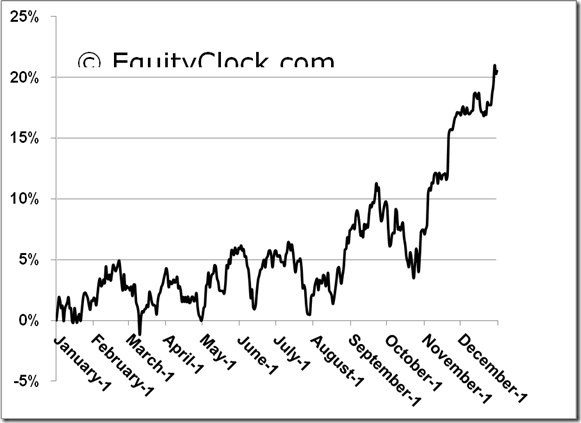
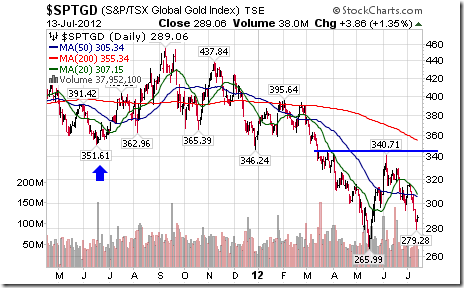
Don Vialoux is the author of free daily reports on equity markets, sectors, commodities and Exchange Traded Funds. He is also a research analyst at Horizons Investment Management, offering research on Horizons Seasonal Rotation ETF (HAC-T). All of the views expressed herein are his personal views although they may be reflected in positions or transactions in the various client portfolios managed by Horizons Investment. Horizons Investment is the investment manager for the Horizons family of ETFs. Daily reports are available at http://www.timingthemarket.ca/ & http://www.equityclock.com/

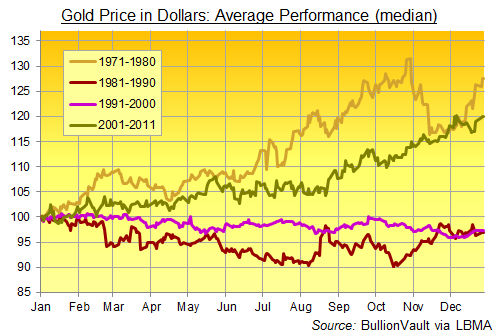 \\
\\

